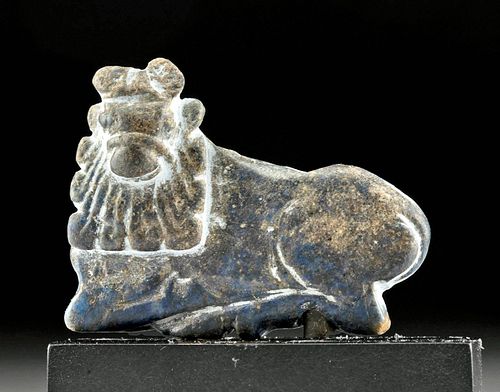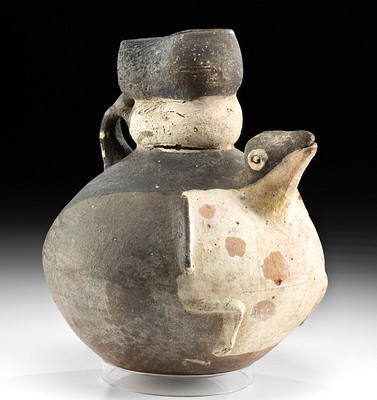Rare Sumerian Lapis Lazuli Recumbent Bull Pendant
Lot 60
About Seller
Artemis Gallery
686 S Taylor Ave, Ste 106
Louisville, CO 80027
United States
Selling antiquities, ancient and ethnographic art online since 1993, Artemis Gallery specializes in Classical Antiquities (Egyptian, Greek, Roman, Near Eastern), Asian, Pre-Columbian, African / Tribal / Oceanographic art. Our extensive inventory includes pottery, stone, metal, wood, glass and textil...Read more
Estimate:
$900 - $1,300
Absentee vs Live bid
Two ways to bid:
- Leave a max absentee bid and the platform will bid on your behalf up to your maximum bid during the live auction.
- Bid live during the auction and your bids will be submitted real-time to the auctioneer.
Bid Increments
| Price | Bid Increment |
|---|---|
| $0 | $25 |
| $300 | $50 |
| $1,000 | $100 |
| $2,000 | $250 |
| $5,000 | $500 |
| $10,000 | $1,000 |
| $20,000 | $2,500 |
| $50,000 | $5,000 |
| $100,000 | $10,000 |
| $200,000 | $20,000 |
About Auction
By Artemis Gallery
Oct 28, 2021
Set Reminder
2021-10-28 12:00:00
2021-10-28 12:00:00
America/New_York
Bidsquare
Bidsquare : Fauna, Flora, Stone & Bones - Fall Edition
https://www.bidsquare.com/auctions/artemis-gallery/fauna-flora-stone-bones---fall-edition-7768
Join us for a very special early Fall auction featuring fabulous fossils, rocks, and minerals, plus art depicting flora and fauna from antiquity to present day. This is one sale you won't want to miss! Artemis Gallery info@artemisgallery.com
Join us for a very special early Fall auction featuring fabulous fossils, rocks, and minerals, plus art depicting flora and fauna from antiquity to present day. This is one sale you won't want to miss! Artemis Gallery info@artemisgallery.com
- Lot Description
Ancient Near East, Mesopotamia, Sumer, ca. 2700 to 2000 BCE. A beautiful and petite example of a hand-carved lapis lazuli bull pendant exhibiting mottled blue, cream, and honey yellow hues. The flat-form piece presents the bovine creature laying recumbent with all four legs tucked beneath its bulky body, its tail draped seamlessly atop its haunches, and its majestic head raised to present its bulging eyes, perky ears, and grand beard. The Sumerians believed strongly in magic, and the magical powers of amulets, created to be deterrents against the Evil Eye. The oldest of these amulets are carved from stone and depict zoomorphic creatures like this example. The bull was a symbol of fertility and virility. A pair of biconically drilled suspension holes through the back and belly suggest this bull was worn as a necklace pendant at one time. Size: 1.08" W x 0.81" H (2.7 cm x 2.1 cm); 2" H (5.1 cm) on included custom stand.
Provenance: East Coast collection, New York Gallery, New York City, New York, USA, acquired before 2010
All items legal to buy/sell under U.S. Statute covering cultural patrimony Code 2600, CHAPTER 14, and are guaranteed to be as described or your money back.
A Certificate of Authenticity will accompany all winning bids.
PLEASE NOTE: Due to recent increases of shipments being seized by Australian & German customs (even for items with pre-UNESCO provenance), we will no longer ship most antiquities and ancient Chinese art to Australia & Germany. For categories of items that are acceptable to ship to Australia or Germany, please contact us directly or work with your local customs brokerage firm.
Display stands not described as included/custom in the item description are for photography purposes only and will not be included with the item upon shipping.
#153352Small chip to obverse of proper left horn. Minor abrasions and softening to some finer details. Great surface smoothness throughout, and great stone coloration still visible.Condition
- Shipping Info
-
All shipping is handled in-house for your convenience. Your invoice from Artemis Gallery will include shipping calculation instructions. If in doubt, please inquire BEFORE bidding for estimated shipping costs for individual items.
-
- Buyer's Premium



 EUR
EUR CAD
CAD AUD
AUD GBP
GBP MXN
MXN HKD
HKD CNY
CNY MYR
MYR SEK
SEK SGD
SGD CHF
CHF THB
THB













